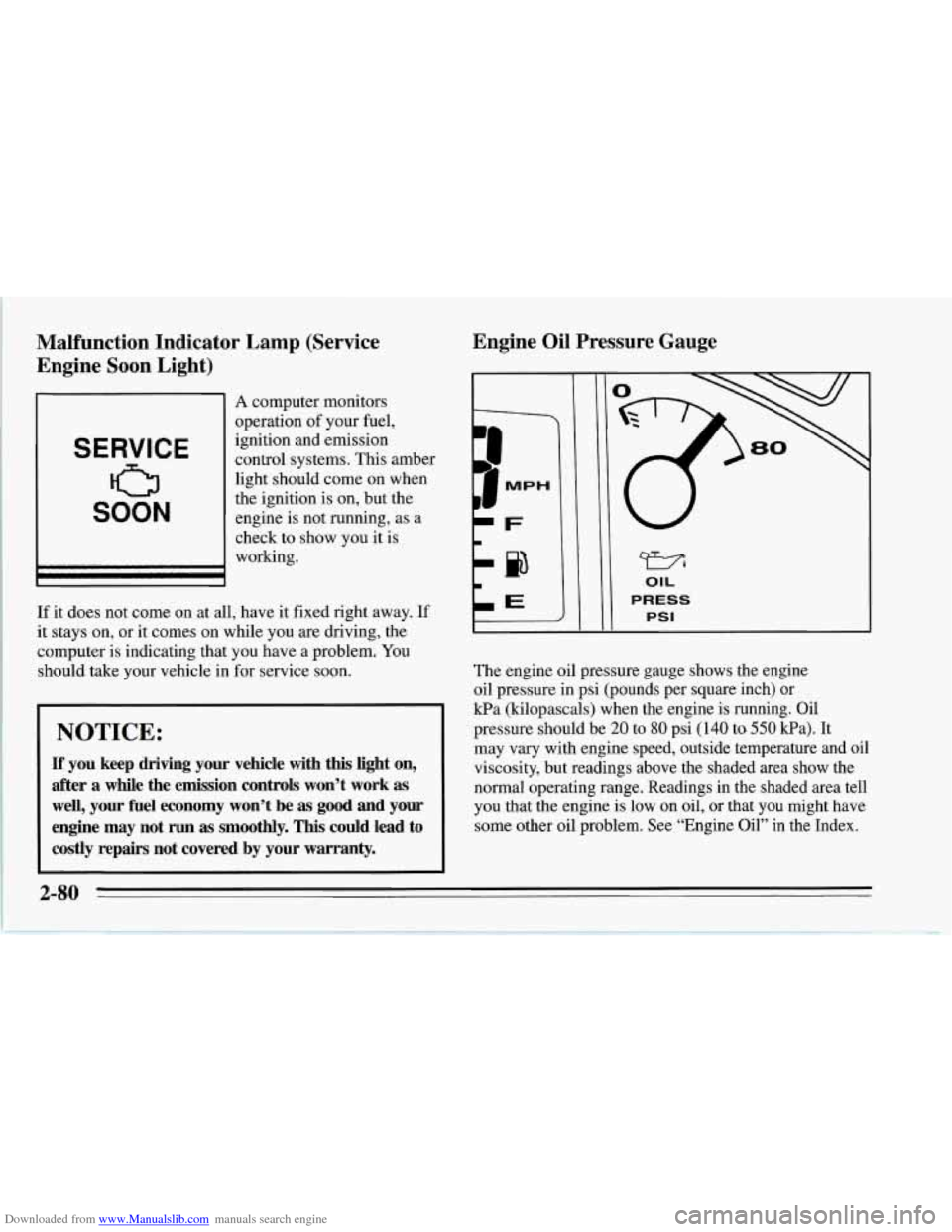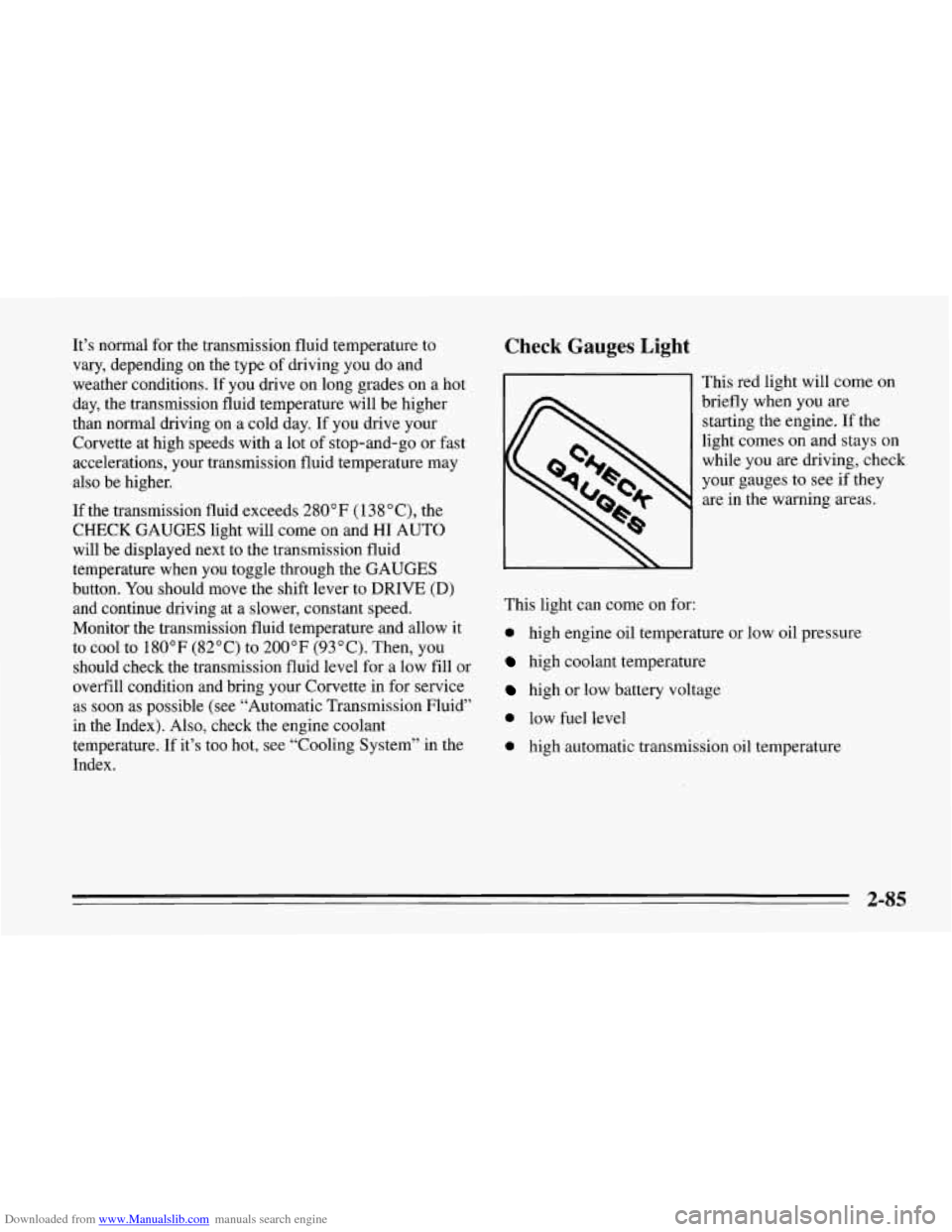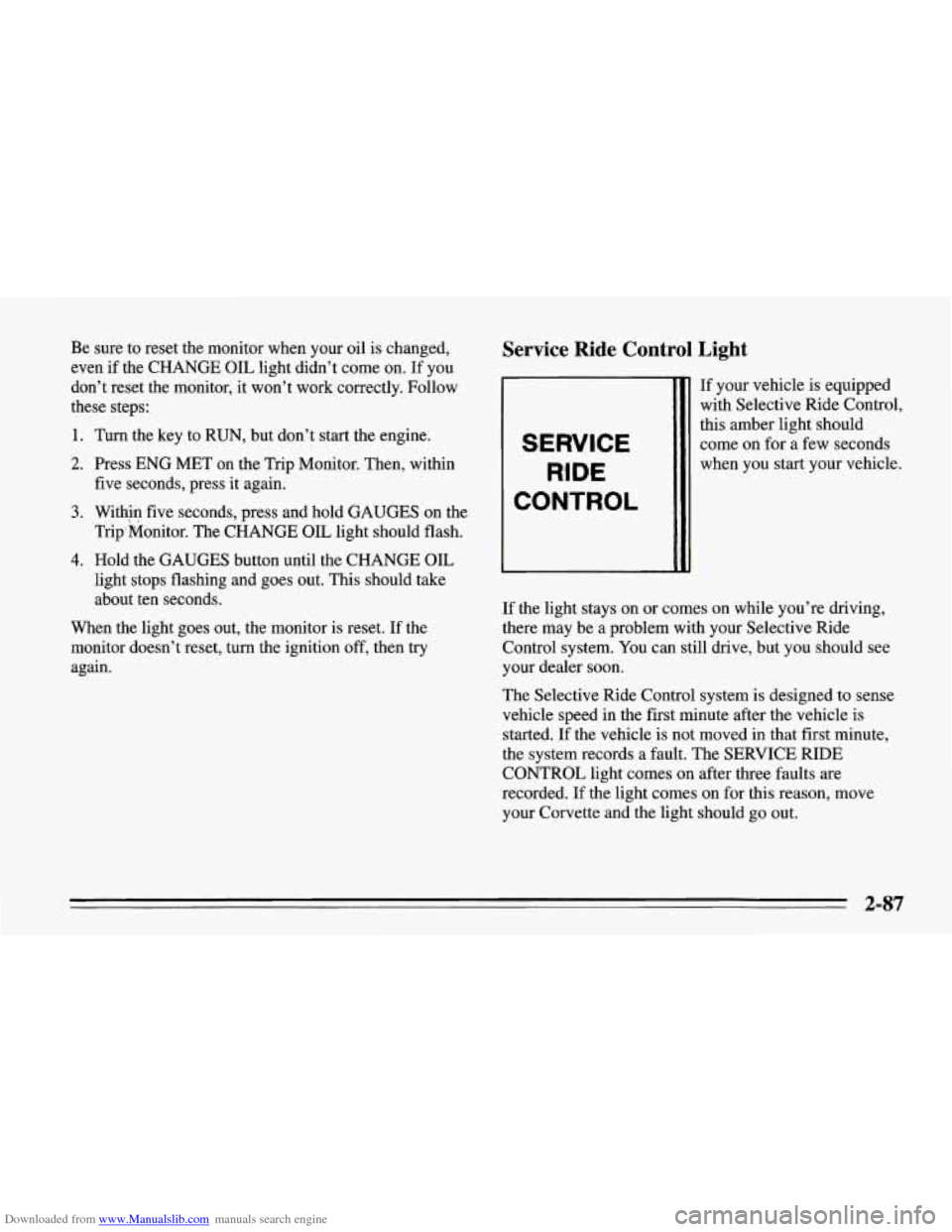Page 120 of 386

Downloaded from www.Manualslib.com manuals search engine For LTPWS to work properly, you must drive your
Corvette faster than
25 mph (40 km/h) and for more
than
2 miles (4 km). The system will not warn you
before
you begin to drive that a tire is flat.
When the LOWLFLAT TIRE light comes
on, check the
tire pressure in all four road tires as soon as you can.
Adjust the tire pressure as needed to those shown
on the
Tire-Loading Information label on the driver’s door.
If
the light stays on after the tire pressure is adjusted, see
your dealer. The
LTPWS sensor is directly opposite the valve stem
on the tire. Take care when servicing or having your
tires serviced. The sensors may not work properly
if
damaged. To prevent damage to the sensors, see the
1995 Corvette Service Manual for correct tire mounting
and dismounting procedures.
The LOWELAT TIRE light may come on if your
vehicle is close to another vehicle that has
LTPWS and
has a tire with low pressure.
LTPWS can warn you about a low tire, but
it does not
replace normal tire maintenance. See “Tires” in the
Index.
NOTICE:
Driving with a flat tire may damage the tire, the
wheel or the tire pressure sensor installed inside
the tire
on the wheel rim. Using tire sealants may
also damage the sensor.
If you have EMTs, see “Extended Mobility Tires”
in the Index.
2-77
Page 121 of 386

Downloaded from www.Manualslib.com manuals search engine Service LTPWS Light (Option)
I
SERVICE
LTPWS
The amber SERVICE
LTPWS light comes on
whenever a LTPWS part is
not working properly. It
may also come on when
you’re going less than
25 mph (40 km/h) or in
stop-and-go traffic.
The light will
go out when the electronic receiver gets a
signal from each sensor.
Check the system by turning the ignition on. The light
should come on and then
go out. See your dealer if the
light stays on or doesn’t come on.
Here
are two situations that cause the SERVICE LTPWS
light to come on and stay on. Both of these situations are
normal and do qot indicate that anything is wrong with
your Corvette.
You turn the ignition on three times in a row for half
an hour without moving your Corvette. The light will
then come on every time you turn the ignition on
until you move your Corvette.
You run your Corvette three times for half an hour
while all four sensors
are missing. (All the sensors
would be missing, for example, if you put different
wheels on your Corvette without transferring the
sensors.)
If you would like to clear the SERVICE LTPWS light
from your driver information center permanently, see
your dealer.
If the light comes on and stays on, even when the
vehicle is driven, there may be a problem with LTPWS.
See your dealer.
Door Ajar Light
This red light comes on
when you open one of the
doors with the ignition on.
It stays on until you fully
close the door. Have your
vehicle serviced
if the light
comes on and stays on even
when the doors are fully
closed.
2-78
Page 123 of 386

Downloaded from www.Manualslib.com manuals search engine Malfunction Indicator Lamp (Service
Engine Soon Light)
SERVICE
0
SOON
I
A computer monitors
operation
of your fuel,
ignition and emission
control systems. This amber
light should come on when
the ignition is on, but the
engine is not running, as a
check to show you it is
working.
If it does not come
on at all, have it fixed right away. If
it stays on, or it comes on while you are driving, the
computer is indicating that you have
a problem. You
should take your vehicle in for service soon.
NOTICE:
If you keep driving your vehicle with this light on,
after
a while the emission controls won’t work as
well, your fuel economy won’t be as good and your
engine may not
run as smoothly. This could lead to
costly repairs not covered by your warranty.
Engine Oil Pressure Gauge
-1
OIL
PRESS
PSI
The engine oil pressure gauge shows the engine
oil pressure in psi (pounds per square inch) or
kPa (kilopascals) when the engine is running. Oil
pressure should be
20 to 80 psi (140 to 550 Ea). It
may vary with engine speed, outside temperature and oil
viscosity, but readings above the shaded area show the
normal operating range. Readings in the shaded area tell
you that the engine is low on oil, or that you might have
some other oil problem. See “Engine Oil” in the Index.
2-80
Page 125 of 386
Downloaded from www.Manualslib.com manuals search engine I 1=1 1 I -1 I
r .
For numeric gauge measurements, press the GAUGES
button on the Trip Monitor until OIL appears. The
number that appears next to the fuel gauge is the oil
temperature.
If LO appears, the temperature is below
32°F (OOC).
System Problems
If SYS flashes on the display near your fuel gauge,
there may be a problem with your Corvette’s electrical
system. If the amber SECURITY light flashes at the
same time, there
is a problem with your theft-deterrent
system. Have your vehicle checked by your dealer
if
SYS keeps appearing.
Gauge Markings
The analog gauges provide a quick visual reference to
the actual measurements of these gauges. However, you
must keep in mind that the gauges aren’t linear. This
means that the middle mark is not a temperature halfway
between the top and bottom temperatures on the gauge.
For your convenience, the following table gives the
exact reading for each mark.
Page 126 of 386
Downloaded from www.Manualslib.com manuals search engine Fuel Gauge
For numeric gauge measurements, refer to the digital
readings by pressing GAUGES on the
Trip Monitor.
Marking
Gauge
E D C B A
LT1 Oil 100
260
235
210
185 100 Coolant
280 250
220
190
100 LT5 Oil
320 285
250
21 5 Temperature
Temperature
Temperature
CF
Your fuel gauge shows about how much fuel is in your
tank. The bars light up when the ignition is on or, if the
ignition is off, when
you turn on your parking lamps.
When the display
is down to the last two bars,
RESERVE will appear next to the gauge.
Here
are three concerns some owners have had about the
fuel gauge. All these situations
are normal and do not
indicate that anything is wrong with the fuel gauge.
At the gas station, the fuel pump shuts off before the
gauge reads
FULL (F).
2-83
Page 128 of 386

Downloaded from www.Manualslib.com manuals search engine It’s normal for the transmission fluid temperature to
vary, depending on the type of driving you do and
weather conditions. If you drive on long grades on a hot
day, the transmission fluid temperature will be higher
than normal driving on a cold day. If you drive your
Corvette at high speeds with a lot of stop-and-go or fast
accelerations, your transmission fluid temperature may
also be higher.
If the transmission fluid exceeds
280°F (138 “C), the
CHECK GAUGES light will come on and HI
AUTO
will be displayed next to the transmission fluid
temperature when you toggle through the GAUGES
button. You should move the shift lever to DRIVE (D)
and continue driving at a slower, constant speed.
Monitor the transmission fluid temperature and allow
it
to cool to 180°F (82°C) to 200°F (93°C). Then, you
should check the transmission fluid level for a low fill or
overfill condition and bring your Corvette in for service
as soon as possible (see “Automatic Transmission Fluid”
in the Index). Also, check the engine coolant
temperature. If it’s too hot, see “Cooling System” in the
Index.
Check Gauges Light
This red light will come on
briefly when you are
starting the engine. If the
light comes on and stays on
while
you are driving, check
your gauges to see if they
are
in the warning areas.
This light can come
on for:
0 high engine oil temperature or low oil pressure
high coolant temperature
high or low battery voltage
0 low fuel level
0 high automatic transmission oil temperature
2-85
Page 129 of 386
Downloaded from www.Manualslib.com manuals search engine Low Oil Light
LOW
OIL
T
This amber light should
come on while you are
starting your engine.
If the
light doesn’t come on, have
it repaired.
If the light
comes on while starting
your engine and stays on,
your engine oil level may be
too low. You may need to
add oil. See “Engine Oil” in
the Index.
Engine Oil Life Monitor
The amber CHANGE OIL
light comes on for a few
seconds when you turn the
ignition
on. It will come on
and stay on when it’s time
to change your oil.
The monitor uses oil temperature and engine revolutions
to decide when the oil is nearly worn out. The light is
only a reminder, though.
You should change your oil at
the intervals recommended in your Maintenance
Schedule, even if the
CHANGE OIL light hasn’t come
on.
2-86
Page 130 of 386

Downloaded from www.Manualslib.com manuals search engine Be sure to reset the monitor when your oil is changed,
even if the CHANGE OIL light didn’t come on. If you
don’t reset the monitor, it won’t work correctly. Follow
these steps:
1. Turn the key to RUN, but don’t start the engine.
2. Press ENG MET on the Trip Monitor. Then, within
five seconds, press it again.
3. Witbin five seconds, press and hold GAUGES on the
Trip’Monitor. The CHANGE OIL light should flash.
4. Hold the GAUGES button until the CHANGE OIL
light stops flashing and goes out. This should take
about ten seconds.
When the light goes out, the monitor is reset. If the
monitor doesn’t reset, turn the ignition
off, then try
again.
Service Ride Control Light
SERVICE
RIDE
CONTROL
If your vehicle is equipped
with Selective Ride Control,
this amber light should
come on for
a few seconds
when you start your vehicle.
If the light stays on or comes on while you’re driving,
there may be
a problem with your Selective Ride
Control system. You can still drive, but you should see
your dealer soon.
The Selective Ride Control system is designed to sense
vehicle speed in the first minute after the vehicle is
started. If the vehicle is not moved in that first minute,
the system records a fault. The SERVICE RIDE
CONTROL light comes on after three faults are
recorded. If the light comes on for this reason, move
your Corvette and the light should
go out.
2-87